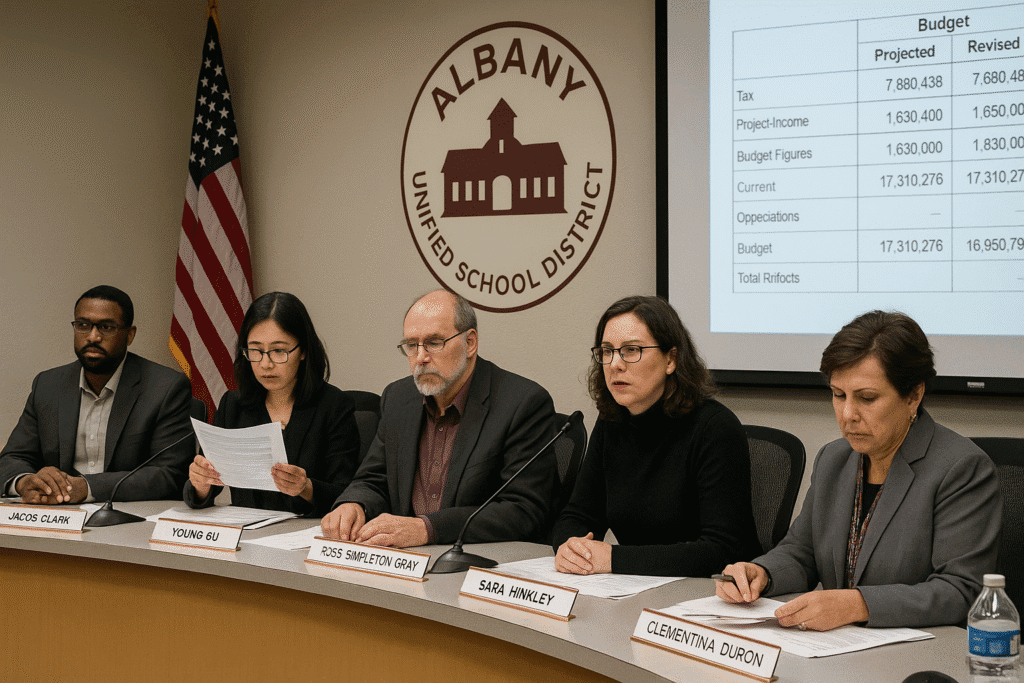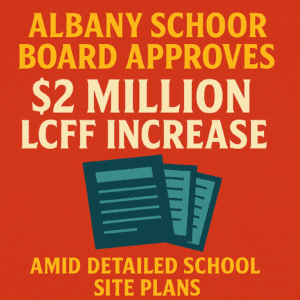Albany Unified School District: A Tale of Two Budgets as Progressive Policies Shape Educational Future


By Tom Wong, Independent Investigative Reporter
July 21, 2025
In the shadow of the San Francisco Bay, Albany Unified School District’s Board of Education recently approved its 2025-26 budget amid a complex financial landscape that reveals both the promise and peril of its progressive educational vision. The June 17th meeting, stretching nearly four hours in City Hall’s Council Chambers, painted a picture of a district celebrating academic achievements while quietly navigating troubling fiscal headwinds—a dichotomy that raises questions about long-term sustainability.
The Numbers Behind the Narrative
While Superintendent Amber Stone’s first six months have been marked by what she called a “meaningful and energizing start,” the financial reality tells a more nuanced story. The district faces projected deficit spending of approximately $494,000 in unrestricted General Fund dollars by the end of the 2024-25 fiscal year, with an additional projected deficit of $399,000 anticipated for 2025-26.
Linda Wu, Chief Business Official, presented these figures with professional calm, attributing them primarily to “increasing costs of living and inflation.” Yet beneath this explanation lies a more complex reality: Albany’s progressive educational policies—while delivering impressive academic results—come with substantial price tags that continue to outpace revenue growth.
The district will receive approximately $2 million in additional Local Control Funding Formula (LCFF) revenue compared to the previous fiscal year, thanks to a 2.3% Cost of Living Adjustment. However, this increase fails to offset rising expenditures, creating what fiscal conservatives might call a structural deficit.
For Albany’s approximately 3,700 students, this translates to a per-student deficit of roughly $133—money that must eventually come from somewhere, whether reserves, program cuts, or increased local revenue measures.
Academic Excellence at What Cost?
The academic picture at Albany Unified appears remarkably strong on the surface. Albany High School Principal Darren McNally reported the school’s best standardized test scores ever, with 84% of students meeting standards in English Language Arts and 70% in mathematics. The high school’s dropout rate has fallen below 2%, with only two non-graduates expected from the class of 2025.
“The median number of sections for a class at Albany High School is two. We have a very diverse number of courses—more than 100 different courses—to meet lots of different student needs,” McNally explained during his presentation.
This educational diversity represents both Albany’s greatest strength and its financial Achilles’ heel. Offering over 100 different courses at a high school with approximately 1,200 students means maintaining numerous small classes—a pedagogically sound but fiscally expensive approach.
The unanimously approved AP African American Studies course exemplifies this trend. Michelle Laosim, who presented the recommendation, noted overwhelming student interest, with four sections planned for next year. While this represents a commendable commitment to diverse curriculum, each new specialized course adds to the district’s staffing requirements and operational costs.
Elementary Schools: Progress and Persistent Gaps
Elementary school principals presented mixed academic results that highlight both progress and persistent challenges in addressing achievement gaps—a core focus of progressive educational policies.
Cornell Elementary reported that while 80% of students continue to meet or exceed grade-level benchmarks, the school saw a slight 2% decline in both English Language Arts and math. More concerning was an 18% decrease in English Learner scores in ELA, though students with disabilities showed a 4% improvement.
At Marin Elementary, Principal Darren Fresquez reported that African-American students increased their math proficiency from 53% to 60%, nearly double the rate from two years ago. The school also saw improvements among socioeconomically disadvantaged students.
Ocean View Elementary Principal Katie Breuer highlighted significant improvements in English Learner progress toward proficiency, a factor that contributed to the school’s Distinguished School Award. The school also saw substantial decreases in chronic absenteeism across all student groups.
These gains, while impressive, come at significant cost. The district’s commitment to equity requires substantial investments in intervention programs, specialized staff, and additional resources for targeted student populations—all worthy expenditures that nevertheless contribute to the district’s financial challenges.
The Arts Funding Equation
The district’s approval of its annual report on Proposition 28 arts funding revealed another aspect of Albany’s educational philosophy. The state funding has enabled expanded art instruction for grades 1-5, new electives including computer education and robotics at the middle school, and additional dance and orchestra sections at the high school.
While these programs undoubtedly enrich student experiences, they also require ongoing maintenance, equipment, and staffing costs that may exceed the dedicated funding stream. The report indicated that equipment and materials purchases were kept within the 20% limit prescribed by the proposition, but long-term sustainability remains a question as these programs become embedded in the district’s educational fabric.
Facilities: The Looming Challenge
Perhaps the most significant financial challenge facing Albany Unified lies in its aging facilities. The board approved a Request for Qualifications/Proposal (RFQ/P) for Master Planning Services and Process to address facility needs across the district. Linda Wu indicated the goal is to develop “a conducive plan on next steps by October 1st.”
The Citizens’ Bond Oversight Committee presented its annual report, noting that 99% of Measure B funds ($72 million) and 94% of Measure E funds ($27 million) have been spent, with approximately $1.6 million remaining for planned projects. This near-depletion of bond funds raises questions about how the district will finance future facility needs without additional bond measures—measures that would further burden local taxpayers.
The district’s facilities challenges are compounded by California’s strict building requirements for schools, including seismic safety standards that significantly increase construction costs. Any comprehensive facilities plan will likely require tens of millions in additional funding—money that isn’t currently identified in the district’s long-term financial projections.
Board Governance: Self-Reflection and Reality
Board President Hopwood presented results from the board’s annual self-evaluation, which identified ethical leadership as a particular strength. Areas for improvement include board training opportunities, policy development, budget education, facilities planning, and legislative advocacy.
“The board environment is described as stable, constructive, and functional,” Hopwood noted, drawing light laughter from fellow board members who jokingly added “surprisingly effective” to the description.
This moment of levity belies a more serious question: Is the board providing sufficient fiscal oversight to ensure long-term sustainability? While the current board appears collegial and well-intentioned, the identification of “budget education” as an area for improvement suggests potential gaps in financial literacy that could impact long-term decision-making.
The Union Factor
Notably absent from public discussion was any mention of labor negotiations or collective bargaining agreements, despite their significant impact on district finances. Albany Unified, like many California districts, allocates approximately 85% of its budget to personnel costs, making labor agreements the single most influential factor in financial planning.
The district’s progressive stance typically includes strong support for teacher unions and competitive compensation packages. While this approach helps attract and retain quality educators, it also creates ongoing financial obligations that grow annually through step-and-column salary increases, even without negotiated raises.
The Taxpayer Perspective
For Albany residents, the district’s financial challenges may eventually translate to requests for additional local funding. Albany has historically supported its schools through parcel taxes and bond measures, with voters approving Measure B ($70 million) in 2016 and Measure E ($25 million) in 2018 for facilities improvements.
The median home value in Albany exceeds $1.2 million, with property owners already paying substantial school-related assessments. As the district faces continued deficit spending and depleted bond funds, taxpayers may soon be asked to approve additional revenue measures—a request that may face increasing scrutiny in the current economic climate.
Looking Forward: Sustainability Questions
As Vice President Mahoney noted during the meeting, the district has moved past immediate COVID-related challenges: “We’re not reopening schools from COVID, we are not hiring superintendents and CBOs. We can actually focus on what we can do for our students.”
This forward-looking perspective is commendable, but it must be balanced with fiscal reality. The district’s projected deficits, while manageable in the short term, point to structural imbalances that could eventually require difficult choices about program priorities, staffing levels, and educational offerings.
Superintendent Stone’s reflection on her first six months highlighted student voices from graduation ceremonies, noting that “our students are modeling what it means to lead with heart, integrity, and courage in this really complex time.” The question remains whether the district’s leadership will model similar courage in addressing financial challenges before they reach crisis levels.
For Albany Unified, the path forward requires balancing its progressive educational vision with fiscal discipline—a challenge that will test the district’s commitment to both educational excellence and financial sustainability in the years ahead.
Tom Wong is an independent investigative reporter focused on local government accountability and educational policy. His reporting examines the intersection of public education, fiscal responsibility, and community impact.









